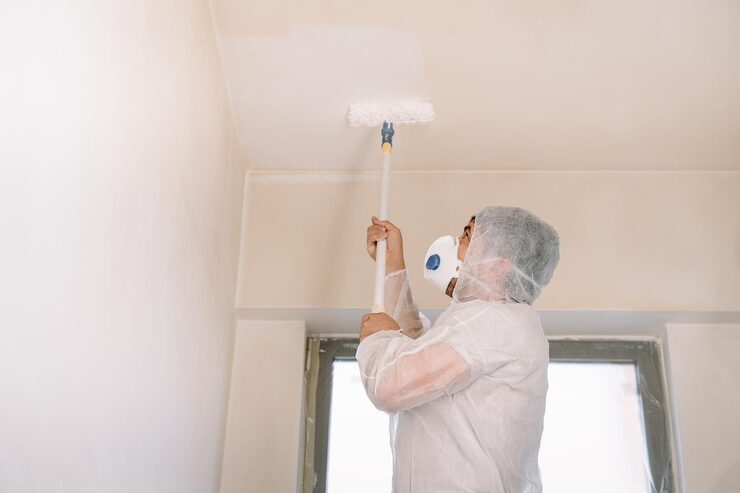- Free Estimates

The difference between a popcorn ceiling and a textured ceiling might seem subtle at first glance, but it can completely change how your home looks, feels, and even sounds. Understanding the pros, cons, and costs behind each style helps you make the right call — whether you’re renovating, painting, or simply tired of those outdated bumps overhead.
✔ Popcorn ceilings are outdated but great for sound absorption and easy to spot by their bumpy texture.
✔ Textured ceilings offer modern, decorative styles that are easier to maintain and repaint.
✔ You can safely cover popcorn ceilings with drywall, planks, or a skim coat for a cleaner look.
✔ A professional painting company ensures safe removal, smooth finishes, and lasting results.
✔ Choosing between popcorn ceiling vs textured ceiling depends on your style, maintenance needs, and home’s age
Popcorn ceilings have a rough, “cottage cheese” look. They were popular in mid-century homes for their ability to hide imperfections and dampen sound. Today, they’re seen as outdated — but still found in many older Fairfield homes.
If you’ve wondered how to do popcorn ceiling, it’s sprayed on with a thick compound made of drywall mud and aggregate materials. It’s quick, inexpensive, and covers flaws easily — though tricky to repair.
Older popcorn ceilings may contain asbestos, while newer ones use safe, lightweight fillers. Always test before scraping or sanding.
Popcorn ceilings collect dust easily and are hard to clean or repaint. That’s why many homeowners choose to cover popcorn ceilings instead of maintaining them.
They’re great for sound absorption, making them common in bedrooms and hallways — though modern materials now achieve similar noise control with a cleaner look.
Thinking about how to do popcorn ceiling work yourself? It’s best left to pros. The process involves:
A licensed painting company can ensure safety and a professional finish — especially if you’re covering popcorn ceilings or replacing them.

A textured ceiling offers smoother, more decorative finishes such as knockdown, orange peel, or swirl. These styles add visual interest and depth without overpowering the room, making them a popular upgrade from the heavy, dated popcorn look.
Textured ceilings are applied using trowels, rollers, or sprayers, depending on the desired finish. This method gives painters greater design control and creates consistent, even patterns throughout the surface.
Most textured ceilings are made with drywall compound, plaster, or specialty texture products. These materials are durable, long-lasting, and easy to refinish when it’s time to repaint.
Compared to popcorn ceilings, textured finishes are far easier to clean and maintain. They resist dust buildup, can be repainted with minimal prep, and rarely chip or flake when properly sealed.
Textured ceilings still provide some sound diffusion, softening echoes and improving overall room acoustics. While they don’t absorb as much noise as popcorn ceilings, they strike a nice balance between style and functionality.
To create a textured ceiling, professionals:
If you’re not sure how to do textured ceiling work correctly, hire a painting company like Fairfield Painting Contractors for a consistent, smooth finish.
Feature | Popcorn Ceiling | Textured Ceiling |
Look | Bumpy and uneven | Smooth or decorative |
Maintenance | Hard to clean | Easy to repaint |
Sound | Excellent absorption | Moderate diffusion |
Style | Outdated | Modern and versatile |
Safety | May contain asbestos | Safe materials |
Today, homeowners prefer smooth or lightly textured ceilings for a cleaner, brighter look. Fairfield Painting Contractors helps clients modernize by covering popcorn ceilings or adding subtle, elegant textures
You may need an upgrade if your ceiling:
A professional painting company can assess whether to repair, cover, or replace it.
Yes. Many homeowners cover popcorn ceiling with drywall, planks, or a skim coat. It’s faster, cleaner, and safer than removing it — especially if asbestos is present.
Removing and replacing a popcorn ceiling typically costs between $1 and $3 per square foot, or about $900 to $2,600 for an average-sized room, depending on ceiling condition, labor rates, and whether asbestos testing is required.
A painting company can give an accurate estimate for your specific project.

Yes, you can paint over a popcorn ceiling, but only after confirming it’s asbestos-free. A professional painting company can handle the prep, sealing, and repainting safely to preserve the texture and prevent flaking.
The easiest way to cover popcorn ceiling is with a skim coat or drywall panels. Both methods create a smooth, modern look without the mess of full removal.
Yes. As long as the surface is clean and primed, a textured ceiling can be applied directly over paint. Many homeowners choose this route for a quick refresh instead of removing old finishes.
Yes, popcorn ceilings can make homes feel dated to buyers. Replacing or covering popcorn ceilings with a subtle texture often increases visual appeal and helps modernize the space.
Most painting companies can remove or refinish a ceiling in one to three days, depending on the room size and texture type. Hiring experts ensures a clean, efficient job with lasting results.
Your ceiling shouldn’t age your home in Fairfield, CT. With decades of hands-on experience, top-quality materials, and a reputation built on trust, our team delivers results that stand the test of time.
Contact Fairfield Painting Contractors today for a free consultation and rediscover how beautiful your ceilings can be.